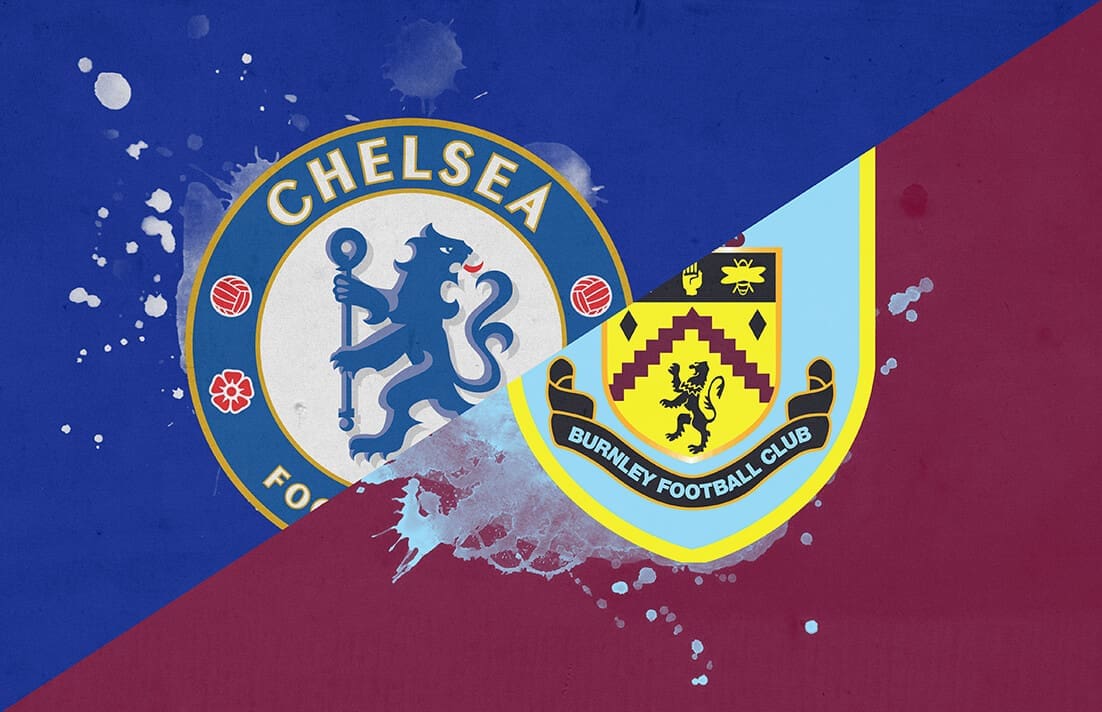This post originally featured on our dedicated Chelsea analysis site, feelchelsea.com
As much as Chelsea’s current pro-attacking tactical set up is making pundits enjoy the Sarriball in the English football set up, the strategy is also really amplifying some defensive vulnerabilities the Blues squad could face. At least for the fixtures which can offer Chelsea strong opportunities to add up not only their points but the goal difference as well, the set up is working well above the expectations. Burnley vs Chelsea was one of them. The tactical analysis below explains how Chelsea’s readiness led them to exploit the home team’s defensive organisation during transitions.
Burnley started with a high press
Burnley executed a high press at the start. The following picture from the match shows how intensely Burnley was pressing Chelsea in the away team’s half. Rudiger has almost all the options blocked in his half.

This fore-pressing initially caused Chelsea’s offensive players to come close to the rear ones until some of them find the outlet towards the open region. The midfield trio often stayed close to each other in a coherent manner to keep the ball flowing. The pass map below shows the coherency of the three to execute short and immediate passing, which had clearly been effective this season due to Chelsea’s impressive results. The presence of the fullbacks at the flanks and their connection with the wider central midfielders in the picture explains that Chelsea also had the outlets to allow the midfielders to pass outside the short passing structures to switch the play when needed.

Burnley’s poor defensive organisation
Chelsea eventually made their way to the final third and opponent goal area and kept their penetration and retention at a high level, thanks to their short passing and vertical tiki-taka style. The pass completion of the midfield trio – Jorginho, Kante, and Barkley – was alone in the range of 92-95 per cent. Overall, Chelsea’s pass completion rate of the match is reported to be 91.9 per cent by Wyscout, which is greater than Chelsea’s overall average and the team’s rate in the previous fixtures.
Besides, it is not just Chelsea’s style but their readiness to exploit Burnley’s weak defensive organisation, which did the job. The home team prominently became defensively weak when on the ball. This made Chelsea win the ball and attack the opponents on transitions. Most of Chelsea’s attempts and goals were made on transitions.
It was Burnley’s weak defensive arrangement which slowed the home team’s ability to hold up Chelsea’s counters and transitional attacks. Many times the whole backline pushed high from its defensive region leaving so much space between them and the goalkeeper. You don’t push your backline so high unless you are highly confident in retaining possession in the middle of the park and that against the opponents which have a highly responsive midfield. The following picture from the match demonstrates not only Chelsea’s backline is highly organised with the centre-backs and the fullbacks not even as a coherent unit, but also the backline is so distant from the goal area. This left so much space open for Willian to exploit and attempt to break the deadlock.

Burnley’s fullbacks and centre backs stepped beyond and out of their position frequently. Their weak defensive coordination was the main reason behind Burnley’s exposed and out-of-position defence line. The following pictures show how much stepped in Burnley’s fullbacks are which is leaving Chelsea’s fullbacks and wingers open in the wider planes.


Again, Burnley’s centre-back, Tarkowski, stepped out of his zone. Being part of an incoherent formation with his counterpart Mee and the fullback Lowton, Tarkowski is creating the passing possibility between Alonso and Morata.

Not only during the defending transitions, but Burnley also exhibited a poor display of defence while Chelsea had retained the ball in the penalty box for a while and the home team had enough time to arrange better. The following match-shot depicts Burnley’s weak defensive organisation when the home team conceded the last goal of the game.

Kante – the main connecting point after Jorginho
As Jorginho was marked, like he is in every match, Chelsea’s passing options were cross-connected by Kante especially at the right vertical half of the pitch. With a pass completion rate of 94 per cent, Kante was such a nice connection between Chelsea’s midfield and attack that his presence and movements helped his teammates a lot in initiating attacks from the left half.
The following match-shot indicates how well Kante is connecting Rudiger to Azpilicueta, as the later is advancing up the width of the pitch, owing to his ball control and adaptable body positioning, while the other passing options are almost blocked for the centreback.

The picture below again explains Kante’s connection role in Chelsea’s build up. As Jorginho and Barkley were blocked by Burnley’s defensive block from the front, Kante dropped back into the open space to get the ball and passed it to Azpilicueta at the right flank to connect the play vertically.

In this way, Kante’s off the ball movements while his team is in an attacking phase allowed Chelsea to keep connected not only across the flanks but also across the defensive and final thirds of the pitch.
To sum up
Chelsea is good at making the most of the attacking transitions – and this is getting better over time. Against the opponents like Burnley, who were defensively exposable and unorganised, Chelsea played as a strong attack-oriented team. They are attack-oriented otherwise too. But they are unleashing their potential to win on attacking transitions over time in a passing-focused Sarriball set up. And this time they were able to do it even without Hazard.





Comments